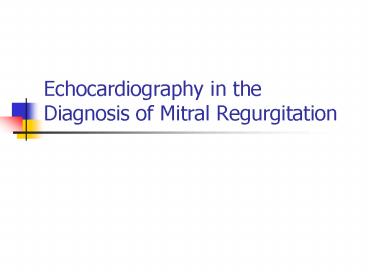Echocardiography in the Diagnosis of Mitral Regurgitation - PowerPoint PPT Presentation
1 / 24
Title:
Echocardiography in the Diagnosis of Mitral Regurgitation
Description:
... from parasternal and apical views provide estimation of ... All three apical views. Subcostal long axis. Doppler/color Doppler. Severe 4 Grade IV ... – PowerPoint PPT presentation
Number of Views:592
Avg rating:3.0/5.0
Title: Echocardiography in the Diagnosis of Mitral Regurgitation
1
Echocardiography in the Diagnosis of Mitral
Regurgitation
2
- Dysfunction or altered anatomy of any one of the
components of the mitral valve apparatus can
result in mitral regurgitation.
3
Etiology and Presumed Mechanisms of MR
4
2-D Criteria
- The left ventricle ejects blood both forward into
the aorta against systemic vascular resistance
and backward into the low-resistance left atrium.
- Since the left ventricle effectively pumps
against the low afterload early in the disease
course, the increase in left ventricular stroke
volume is achieved mainly by more complete left
ventricular emptying (an increase in ejection
fraction) rather than by left ventricular
dilation.
5
2-D Criteria
- 2-D and M-mode echo are useful in detecting the
underlying cause of mitral regurgitation - The left ventricle is expected to appear
hyperdynamic on 2D imaging when mitral
regurgitation is present.
6
2-D Criteria
- With chronic regurgitation, progressive left
ventricular dilation eventually occurs as the
regurgitant volume increases the LV is
hyperdynamic. So accurate LV measurements should
be taken. - The left atrium gradually dilates to accommodate
the regurgitant volume while maintaining a normal
left atrial pressure. So the LA should be
measured.
7
2-D Criteria
- With acute MR, the regurgitant volume is
delivered into a small, noncompliant left atrium,
resulting in a significant increase in left
atrial pressure. - Echocardiographic evaluation of the patient with
mitral regurgitation includes noninvasive
measurement of pulmonary artery pressure from the
tricuspid regurgitant jet velocity and estimate
of RA pressure
8
2-D Criteria
- This is performed because, pulmonary artery
pressure rises passively in response to both the
chronic mildly elevated left atrial pressure seen
with chronic mitral regurgitation and the acute
severe elevation seen with acute regurgitation. - When left atrial pressure is chronically
elevated, pulmonary vascular resistance may
increase
9
CM-mode and M-mode
- Can help in the evaluation of the time of the MR
relative to the systolic cycle - LA and LV size are usually dilated although could
be normal in mild MR - Can cause early systolic closing of the aortic
valve - Rounded E point
- Hyperdynamic LV motion
10
Evaluation of Hemodynamic Severity
- The amount of regurgitant flow must be determined
- The effect of the regurgitation on the left
ventricle, i.e., the degree of left ventricular
volume loading, must be assessed - The effect of the regurgitation on left atrial
and pulmonary venous pressure, i.e., the degree
of LA/pulmonary venous loading, must be determine
11
Doppler/color Doppler
- Multiple Doppler parameters can be used to assess
the quantity of mitral regurgitant flow. These
include both semi-quantitative parameters such as
- peak velocity of forward flow across the MV
during diastole, which increases as the
regurgitant volume increases, - area, and length of the regurgitant jet as assess
by color Doppler, - width of the regurgitant jet by the point of
valve leaflet apposition (vena contracta) - and the intensity of the spectral Doppler
velocity profile
12
Doppler/color Doppler
- All these parameters correlate with angiographic
estimations of severity when MR is either mild or
severe. - However, in patients with moderate degrees of MR
these parameters have been less definitive
13
Doppler/color Doppler
- CW may be useful in quantitative assessment of
severity (increase density of the envelop) - The velocity of the mitral regurgitation tends to
be lower lt5m/sec with increasing severity because
the increase LA pressure reduces the transmitral
systolic gradient - Acute MR the jet will peak in early systole
14
Doppler/color Doppler
15
Doppler/color Doppler
- In MR, antegrade flow (mitral inflow) velocity
may be increased with severe regurgitation. - Peak mitral diastolic velocity (E point) gt1.5
m/sec with normal pressure ½ time is severe MR
16
Doppler/color Doppler
- In the parasternal views use pulsed color Doppler
flow in the LA for systolic turbulence and to
evaluate the Vena Contracta - Vena Contracta gt0.5cm is considered significant
17
Doppler/color Doppler
- mapping technique of flow disturbance from
parasternal and apical views provide estimation
of severity using pulsed and more commonly color
Doppler
18
Doppler/color Doppler
- MR should be assessed in all views
- Parasternal long and short axis
- All three apical views
- Subcostal long axis
19
Doppler/color Doppler
20
Doppler/color Doppler
- In color flow imaging of MR, the area of the
regurgitant jet relative to the size of the LA is
most predictive of regurgitant severity
determined by angiography
21
Doppler/color Doppler
- Jet area is more reliable than jet length method
in mapping. It is done by planimetry of the
regurgitant jet in the LA and RA then dividing by
the left or right atrial areas
22
Doppler/color Doppler
- Pulmonary Vein Flow reversal
- Use the right upper pulmonary vein
- Place the PW Doppler cursor at least .5 to 1 cm
into the pulmonary vein - Open the Doppler gate to 1 cm
- Set the Doppler spectral sweep speed to 100 msec
23
Doppler/color Doppler
24
Example































